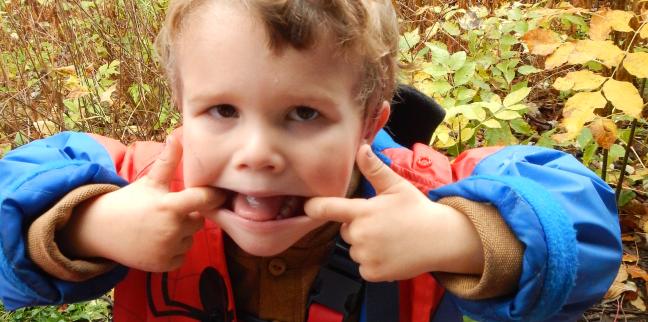Lately, my Facebook feed has exploded with pictures of children playing in nature. This is not surprising. As the Director of a Nature Preschool just north of downtown Milwaukee, I follow a number of groups online, among them: The Children and Nature Network, the Natural Start Alliance, the Wisconsin Nature Action Collaborative for Children, and the International Association of Nature Pedagogy.
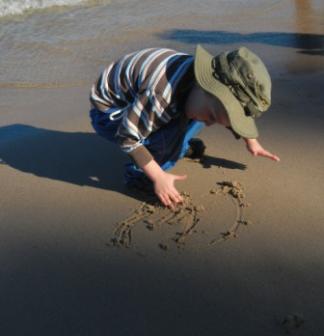
It is thrilling to see nature-based education taking off in such a big way, and in so many preschools across the globe. I am certain that this is a direct result of children spending more of their days--and evenings--sitting immobile in front of screens; of technology taking precedence over outdoor experiences; of school recess shrinking as student testing increases. Parents are growing alarmed at how disconnected young people seem to have grown from the natural world beyond their door. Grandparents despair that this new generation is overprotected and socially isolated, preferring their phones to actual conversations. Nature has become a hands-off experience.
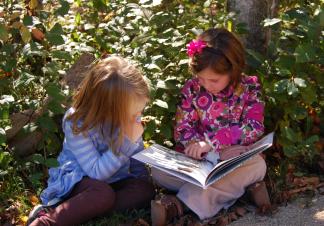
So, all in all, I am delighted to open my Facebook feed and see image after image of happy children hanging from trees, squelching in mud, or carefully dipping their nets into ponds.
And yet. Very quickly, all of these images start to look the same. I often cannot tell if a photo was taken in New Zealand or New Jersey. There is the small muddy hand, carefully clutching an acorn cap. There is the child leaping with glee into a great big pile of leaves. There is a romanticism to these images that becomes almost boring after a while.
Of course, I understand the desire to post only the best images on Facebook. And having personally taken thousands of pictures of children playing outdoors, I am as guilty as anyone when it comes to filtering out the whole truth. Take, for instance, the video I shot of a small group of four-year-old boys hauling a log across a muddy play space. In the video, the boys work as a team, offering one another encouragement as they maneuvered the log from one place to another. Other children quickly rush in to help. Playing in nature leads to cooperative play, the video seems to imply. And while this is true, it does not tell the whole story, which is that seconds after the video ends, the log crashed to the ground, the kids started yelling, and a teacher had to intervene.
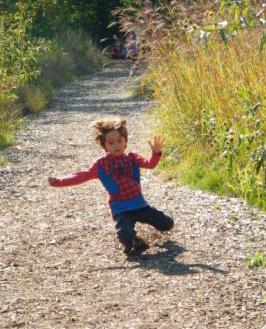
It is worth asking ourselves: what is the deeper purpose of all these photographs? Are we documenting children engaged in play? Or are we reassuring ourselves that as teachers and parents we are providing children with profound experiences? I believe we need to fight the urge to promote nature and childhood through rose-colored glasses. We do not tell the whole truth when we imply that all children need are a few pine cones and sticks and they will never be bored or cranky again.
One of my favorite online diversions is a webpage devoted to “Pinterest Fails.” As someone who never mastered the art of the frosting rosette, or even the perfect preschool bulletin board, these disastrous attempts at Pinterest projects always make me smile. It is reassuring to me that not everyone is an expert at crafting and cake decoration. And lately, as I peruse photo after photo of sun-filtered children holding hands under looming birch trees, I am tempted to dig out some of our photos that did not make the final cut, to reassure myself that not every moment in nature is golden. I want to see the child who stuck his hand into an icy puddle and is now wailing because his mitten is soaked. I want to see the child standing with her sock half-off, with her boot stuck deep in the mud. I want to see the children’s garden in which the lettuce has been eaten, the marigolds picked, and the vegetables hopelessly overwatered.
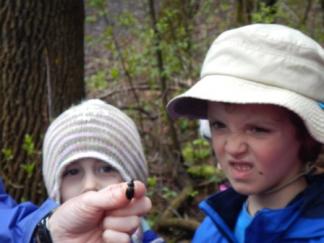
The next time I take a camera in hand, documenting the magic that happens when you give children time to play freely in nature, I am going to resist the urge to hit pause. Nature is tricky. Paths can be icy. As adults, we must fight the urge to project our own romanticized view of nature and childhood onto this new generation. There will always be the child who glares, or pushes, or bursts into tears the moment we click the camera. There will always be one who looks down at the ground, just when a monarch butterfly goes by.
About the Author
Catherine Koons Hubbard is the Nature Preschool Director at Schlitz Audubon Nature Center in Milwaukee, Wisconsin. She holds a Master’s Degree in Education from the University of Pennsylvania, and has worked as a teaching naturalist for over fourteen years. She enjoys taking children outdoors in all sorts of weather, and while she has a beautiful collection of idyllic photographs featuring children engaged in nature play, she has recently begun a much more entertaining, and just as realistic, collection of non-idyllic photos, which are likely to show children making faces, recoiling from worms, and covered from head to toe in mud.


